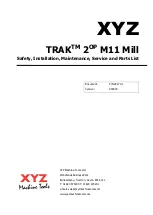
Chapter 1: Configuration
Configuring radio parameters
Page
1-175
Attribute
Meaning
Frequency Band
Select the operating frequency band of the radio. The supported bands are
4.9 GHz, 5.4 GHz and 5.7 GHz.
Frequency Carrier
Specify the frequency for the module to transmit. The default for this
parameter is None. For a list of channels in the band, see the drop-down list
on the radio GUI.
Channel Bandwidth
The channel size used by the radio for RF transmission. The setting for the
channel bandwidth must match between the BHM and the BHS.
Cyclic Prefix
OFDM technology uses a cyclic prefix, where a portion of the end of a
symbol (slot) is repeated at the beginning of the symbol to allow multi-
pathing to settle before receiving the desired data. A 1/16 cyclic prefix
means that for every 16 bits of throughput data transmitted, an additional bit
is used.
Frame Period
Select the Frame Period of the radio. The supported Frame Periods are: 5 ms
and 2.5 ms.
Color Code
Specify a value from 0 to 254. For registration to occur, the color code of
the BHM and the BHS must match. Color code is not a security feature.
Instead, color code is a management feature, typically for assigning each link
a different color code.
Color code allows you to force a BHS to register to only a specific
BHM. The default setting for the color code value is 0. This value
matches only the color code of 0 (not all 255 color codes).
Sector ID
This pull-down menu helps in configuring the Sector ID at a configurable
value from 0 to 15.
Large VC data Q
Enable Large VC Q for applications that burst data high rates. Large
Qs may decrease effective throughput for TCP application.
Disable Large VC Q if application need not handle bursts of data.
Large Qs may decrease effective throughput for TCP application.
MIMO Rate Adapt
Algorithm
This pull-down menu helps in configuring the Rate Adapt Algorithm to
MIMO-A/B, MIMO-B only, or MIMO-A only.
Summary of Contents for PTP 450 Series
Page 51: ...Chapter 1 Configuration Quick link setup Page 1 23...
Page 155: ...Chapter 1 Configuration Configuring security Page 1 127...
Page 163: ...Chapter 1 Configuration Configuring security Page 1 135...
Page 164: ...Chapter 1 Configuration Configuring security Page 1 136...
Page 193: ...Chapter 1 Configuration Configuring radio parameters Page 1 165...
Page 194: ...Chapter 1 Configuration Configuring radio parameters Page 1 166...
Page 195: ...Chapter 1 Configuration Configuring radio parameters Page 1 167...
Page 206: ...Chapter 1 Configuration Configuring radio parameters Page 1 178...
Page 210: ...Chapter 1 Configuration Configuring radio parameters Page 1 182...
Page 636: ...Chapter 5 Troubleshooting Logs Page 5 16 Figure 95 SM Authorization log...
















































